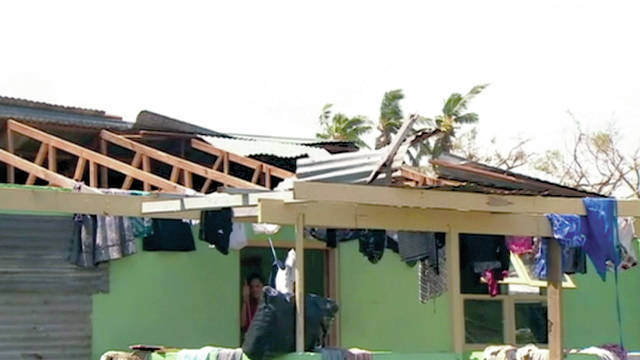WELLINGTON, New Zealand — Thousands of Tonga residents face a long wait for power and other services to be restored after a cyclone tore through the Pacific nation this week.
More details emerged Wednesday about the damage caused by Cyclone Gita after it hit the main island Monday night just south of the capital, Nuku’alofa. The cyclone destroyed homes, churches and even the nation’s historic Parliament House.
There have been no confirmed deaths from the storm. Tongan police said three people suffered major injuries and 30 had minor injuries. Police said an officer was injured while trying to help a family evacuate and was in stable condition in a local hospital.
Most of the main island remains without power and many phone lines aren’t working.
Publisher Pesi Fonua said he’s using a small generator, but that many people with refrigerators will have to toss out food. He said he’d heard it would likely be next week at the earliest before his power is restored.
“Yesterday, nothing happening. Everyone was in shock,” he said. “But slowly, slowly things are happening. The telephones are slowly working. They’re restoring the power lines.”
Kuenili Ka’afi told Newshub that she took shelter in a van when the cyclone hit, having time to grab only a family photo as the winds tore her home apart. She said the cyclone started shaking and lifting the van, and that she felt lucky to be alive.
Some 5,000 people stayed in evacuation centers during Cyclone Gita, according to officials. Tonga, which is home to about 106,000 people, has declared an emergency.
New Zealand has pledged 2.25 million New Zealand dollars ($1.65 million) in aid to help with the cleanup from the cyclone in several island nations, while Australia is deploying equipment worth hundreds of thousands of dollars.
The cyclone caused some damage in Fiji on Tuesday night, although its path was south of the major population centers.
Anare Leweniqila, the director of Fiji’s National Disaster Management Office, said six homes were destroyed and another 27 damaged on two of the nation’s southern islands. He said there were no reports of deaths or serious injuries in Fiji.
“It came down to good preparedness,” he said. “People heeded the advice from officials and took shelter early in the day before the cyclone hit.”
He said about 150 people had moved into evacuation centers.
The storm hit Samoa and American Samoa last week, where it caused damage to buildings, widespread power outages and flooding.
President Donald Trump on Sunday declared an emergency in American Samoa, a U.S. territory. The declaration allows the Federal Emergency Management Agency to provide equipment and resources to help the 50,000 residents recover.






